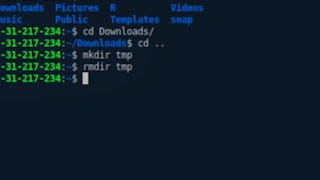This course begins by introducing you to the Linux environment, guiding you through installation on VirtualBox, and getting comfortable with the terminal interface. You'll start by learning basic file navigation commands like pwd, ls, and cd to explore the Linux file system. As you progress, you'll dive deeper into the practical aspects of file management, covering everything from creating and managing files and directories to editing text files directly from the terminal using Nano and Echo.



Recommended experience
Recommended experience
What you'll learn
Explain the function of file permissions, ownership, and user roles in Linux.
Execute terminal commands to manage files, directories, and permissions effectively.
Differentiate between absolute and relative paths, and assess system processes using monitoring tools.
Troubleshoot issues related to file permissions, software installation, and process management.
Details to know

Add to your LinkedIn profile
5 assignments
See how employees at top companies are mastering in-demand skills


Earn a career certificate
Add this credential to your LinkedIn profile, resume, or CV
Share it on social media and in your performance review

There are 11 modules in this course
In this module, we will introduce the course, outline the learning journey, and guide you through the essential steps to set up your Linux environment. You'll start by installing Ubuntu on VirtualBox and familiarizing yourself with the terminal interface. These foundational skills will set you up for success in the upcoming modules.
What's included
4 videos1 reading
In this module, we will dive into the Linux file system and explore essential commands for navigating within it. You will learn how to move between directories, view hidden files, and leverage time-saving shortcuts like autocompletion and command history. Understanding the structure of the Linux file system, including the home directory and path types, is key to mastering file management.
What's included
6 videos
In this module, we will focus on managing files and directories within the Linux environment. You will learn how to create, move, and remove files and folders, as well as explore the contents of files directly from the terminal. Additionally, you'll practice writing text into files using commands like echo, further developing your ability to work efficiently in Linux.
What's included
4 videos1 assignment
In this module, we will cover file editing techniques using the terminal-based Nano editor and explore how to configure it for personalized usage. You will also learn how to create and run Bash scripts, a crucial skill for automating tasks in Linux. Finally, we’ll provide an introduction to Vim, another powerful terminal-based text editor.
What's included
4 videos
In this module, we will explore how user accounts and permissions work in Linux. You'll learn about the actions you can and cannot perform as a regular user and how to elevate privileges using sudo. We will also cover file ownership and permission structures, providing you with the knowledge to modify owners and adjust access levels with commands like chown and chmod.
What's included
5 videos
In this module, we will guide you through the process of installing, removing, and updating software in Linux. You’ll learn how to use popular package managers such as apt, yum, and brew, and explore how to keep your system updated. Additionally, we'll introduce Snap, a powerful tool for managing software on Ubuntu.
What's included
3 videos1 assignment
In this module, we will focus on enhancing your productivity in the Linux command line. You will learn how to quickly find files, search for patterns within files, and use pipes to link commands together for more efficient processing. We'll also cover essential terminal shortcuts and how to work with multiple terminals to manage tasks more effectively.
What's included
5 videos
In this module, we will explore how to manage and monitor system processes and resources in Linux. You will learn how to find and kill processes that may be consuming system resources unnecessarily. Additionally, you will gain the ability to monitor disk space, CPU usage, and power consumption to ensure your system is running efficiently.
What's included
2 videos1 assignment
In this module, we will cover essential network commands to help you manage and troubleshoot network connectivity in Linux. You'll also learn how to securely connect to your Linux system remotely using SSH. Lastly, we will provide a brief introduction to Embedded Linux, highlighting its importance and how the command line is used within this context.
What's included
3 videos
In this module, we will focus on automating tasks in Linux to improve efficiency. You'll learn how to schedule tasks using Cron jobs and configure services to start automatically during boot with Systemd. Additionally, we will cover how to modify existing Cron jobs for better task management.
What's included
2 videos1 assignment
In this final module, we will summarize the key takeaways from the course and provide guidance on what steps to take next. You'll receive advice on continuing your Linux education, exploring advanced topics, and leveraging your newfound skills to advance your career in system administration or related fields.
What's included
1 video1 assignment
Instructor

Offered by
Recommended if you're interested in Networking


Coursera Project Network
Why people choose Coursera for their career




New to Networking? Start here.

Open new doors with Coursera Plus
Unlimited access to 10,000+ world-class courses, hands-on projects, and job-ready certificate programs - all included in your subscription
Advance your career with an online degree
Earn a degree from world-class universities - 100% online
Join over 3,400 global companies that choose Coursera for Business
Upskill your employees to excel in the digital economy
Frequently asked questions
Yes, you can preview the first video and view the syllabus before you enroll. You must purchase the course to access content not included in the preview.
If you decide to enroll in the course before the session start date, you will have access to all of the lecture videos and readings for the course. You’ll be able to submit assignments once the session starts.
Once you enroll and your session begins, you will have access to all videos and other resources, including reading items and the course discussion forum. You’ll be able to view and submit practice assessments, and complete required graded assignments to earn a grade and a Course Certificate.
More questions
Financial aid available,






